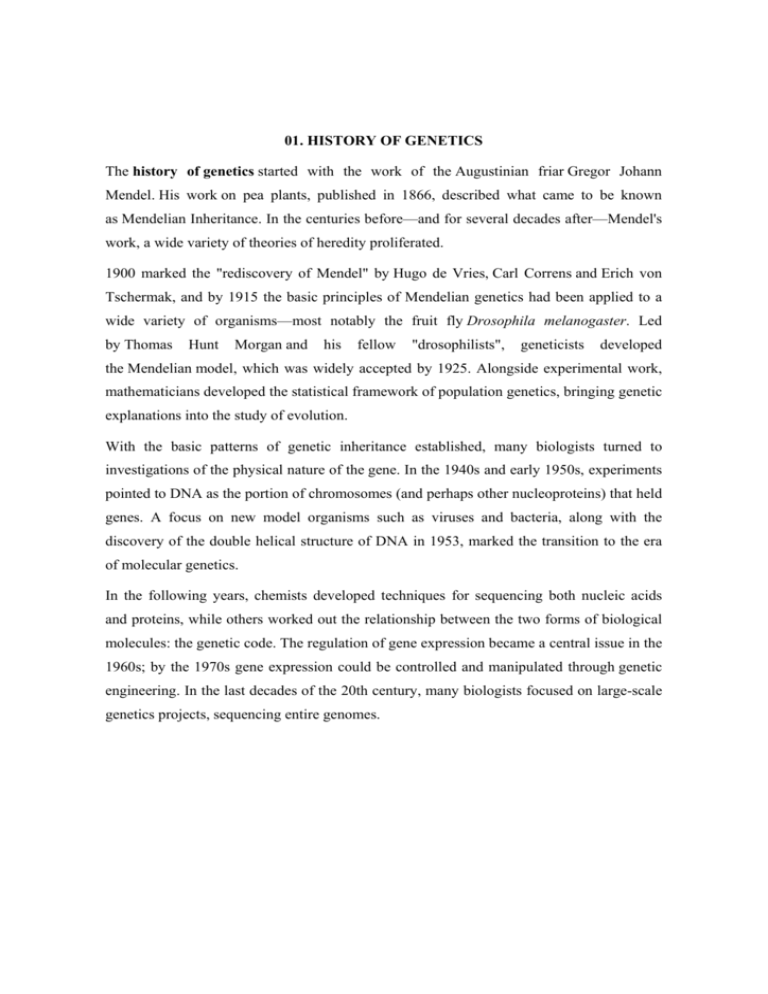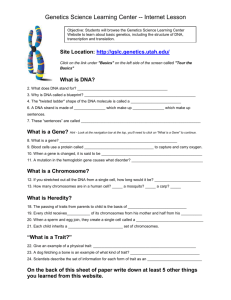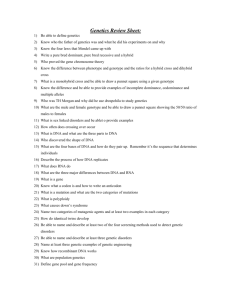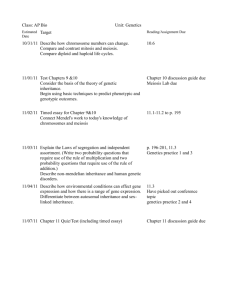Lec 01 - History of Genetics
advertisement

01. HISTORY OF GENETICS The history of genetics started with the work of the Augustinian friar Gregor Johann Mendel. His work on pea plants, published in 1866, described what came to be known as Mendelian Inheritance. In the centuries before—and for several decades after—Mendel's work, a wide variety of theories of heredity proliferated. 1900 marked the "rediscovery of Mendel" by Hugo de Vries, Carl Correns and Erich von Tschermak, and by 1915 the basic principles of Mendelian genetics had been applied to a wide variety of organisms—most notably the fruit fly Drosophila melanogaster. Led by Thomas Hunt Morgan and his fellow "drosophilists", geneticists developed the Mendelian model, which was widely accepted by 1925. Alongside experimental work, mathematicians developed the statistical framework of population genetics, bringing genetic explanations into the study of evolution. With the basic patterns of genetic inheritance established, many biologists turned to investigations of the physical nature of the gene. In the 1940s and early 1950s, experiments pointed to DNA as the portion of chromosomes (and perhaps other nucleoproteins) that held genes. A focus on new model organisms such as viruses and bacteria, along with the discovery of the double helical structure of DNA in 1953, marked the transition to the era of molecular genetics. In the following years, chemists developed techniques for sequencing both nucleic acids and proteins, while others worked out the relationship between the two forms of biological molecules: the genetic code. The regulation of gene expression became a central issue in the 1960s; by the 1970s gene expression could be controlled and manipulated through genetic engineering. In the last decades of the 20th century, many biologists focused on large-scale genetics projects, sequencing entire genomes. HISTORICAL DEVELOPMENTS IN GENETICS Year Scientist Contribution 1485 L. da Vinci Recommended the use of lenses for viewing small objects 1590 Z. Janssen and H. Janssen Produced the first operational microscope. 1665 R. Hooke Introduced the term “ cell ” and described cork cells. 1668 F. Redi Disproved the theory of spontaneous generation of maggots. 1672 Malphigi Classified the tissues. 1674 A.van Leeuwenhoek Improved lens system of microscope by grinding. 1682 N. Crew Described bladders and pores in wood and pith. 1694 J.R. Camerarius Conducted early experiments on pollination and reported the existence of sex in plants. 1700 R. Linnaeus Classified the biological organisms. 1761 J.C. Kolreuter Hybridized various species of tobacco and concluded that each parent contributed equally to the characteristics of the progeny. 1779 C.F Wolff Founder of embryology. 1809 J.B. Lamarck Coined the word “ biology ” and stressed the importance of cell in living organisms. He put forth the theory of inheritance of acquired characters. 1824 Dutrochet Showed that all plants and animals are composed of cells. 1825 F.V. Raspail Developed the frozen-section technique and used iodine for detection of starch. 1835 H. von Mohli Emphasized the importance of protoplasm and described cell division. 1837 R. Brown Discovered the nucleus in cells of flowering plants. Year Scientist Contribution 1838 M.J. Schleiden and T. Schwann Formulated the cell theory in plants and animals. 1840 J.E. Purkinj Gave the term “ protoplasm ”. 1845 A. Donne Used photomicroscopy for the first time. 1846 K. Nageli Showed that plant cells arise from the division of preexisting cells. 1846 G.B. Amici Showed that egg in the ovary is stimulated to develop into an embryo by the entrance of pollen tube. 1858 R. Virchow Showed that animal cells arise from the division of pre existing cells. 1859 C. Darwin Put forth the theory of natural selection. 1862 Kolliker Used the term “ cytoplasm ”for the living material surrounding the nucleus. 1865 G. Mendel Developed the fundamental principles of heredity. 1870 W. His Invented the microtome. 1871 F. Meischer Isolated nucleic acids from pus cells. 1873 H. Fol Described spindle and astral rays. 1875 O. Hertwig Studied reproduction in sea urchins and concluded that fertilization involves the union of sperm and egg nucleus. 1875 E. Strasburger Discovered cell division in plants and gave the terms “ cytoplasm ” and “ nucleoplasm ”. 1879 W. Flemming Introduced the term “ chromatin ”. 1879 H. Fol Showed that only one sperm enters the egg during fertilization. 1881 E.G. Balbiani Discovered giant chromosomes in salivary glands of Drosophila. 1882 W. Flemming Coined the term “ mitosis ” . 1883 W. Rouse Proposed that chromosomes contain genes which are the units of heredity. Year Scientist Contribution 1885 A.F.W. Schimper Introduced the term “ plastids ”. 1888 Th. Boveri C oined the term “ centrosomes ”. 1888 W. Waldeyer Coined the term “ chromosomes ”. 1892 O. Hertwig Proposed the protoplasm theory of inheritance. 1892 J. Ruckert Described lamp brush chromosomes in oocytes of shark. 1892 W. Weisman Stated that chromosomes are the most important part of the nucleus. 1892 Th. Boveri Described meiosis in Ascaris. 1898 C. Golgi Described the golgi apparatus in nerve cells. 1898 C. Benda Discovered mitochondria in spermatozoa and other cells. 1899 S. Altman Introduced the term “ nucleic acid ”. 1900 C.E. Correns, H. de Vries and E. Tschermak R e-discovered Mendel’s laws of inheritance. 1901 E. Strasburger Introduced the term “ plasmodesmata ”. 1902 C.E. McClung Identified sex chromosomes in bugs. 1902 H. de Vries Coined the term “ mutation ”. 1902 W.S. Sutton Proposed the chromosome theory of heredity and identified chromosomes as carriers of genetic material. Th. Boveri 1903 W. Waldeyer Proved centromeres are the chromosomal regions with which the spindle fibres become associated during mitosis 1905 L.Cuenot Discovered lethal genes affecting coat colour in mice. 1905 J.B. Farmer and J.E. Moore Coined the term “ meiosis ”. 1906 W. Bateson Coined the term “ Genetics ”and proposed the concept of allele. 1906 W. Bateson and R.C. Punnet Discovered genetic linkage in sweet pea. Year Scientist Contribution 1906 W.L. Johannsen Coined the terms “gene”, “genotype” and “phenotype”. 1909 W. Bateson Coined the term “ epitasis ”. 1909 C. Correns Reported cytoplasmic inheritance in Mirabilis jalapa. 1909 F.A. Janssens Indicated that chiasmata are produced by exchanges between non -sister chromatids of homologous chromosomes. 1910 T.H. Morgan Studied crossing over and recombination in Drosophila and coined the term “ crossing over ”. 1910 H. Nilsson-Ehle Proposed the multiple factor hypothesis. 1911 A.H. Sturtevant Constructed the first linkage map in Drosophila. 1912 Vejdovsky Coined the term “ chromonema ”. 1915 T.H. Morgan Correlated genetic studies with cytological studies. He put forth the theory of linkage and studied sex linked inheritance in Drosophila melanogaster. 1917 C.E. Allen Discovered sex determination in plants. 1921 F.G. Banting Isolated insulin. C.H. Best 1922 C.B. Bridges Put forth the genic balance theory of sex determination. 1923 C.B. Bridges Discovered duplications, deletions and translocations in chromosomes. 1923 Crew Reported complete reversal of sex in hens. 1924 A.F. Blakeslee and J. Belling Studied trisomics in Jimson weed (Datura stromonium). 1924 R. Feulgen Described a test to confirm the presence of DNA. 1926 A.H. Sturtevant Discovered inversions in chromosomes. 1927 G.K. Karpechenko Synthesized Raphano brassica. 1927 H.J. Muller Induced mutations in Drosophila melanogaster by X-rays 1928 L.J. Stadler Induced mutations in maize and barley by X-rays. Year Scientist Contribution 1928 F. Griffith Conducted experiments on transformations in Diplococcus pneumonia. 1931 C. Stern Gave cytological proof for crossing over in Drosophila. 1931 H. Creighton and B. McClintock Gave cytological proof for crossing over in maize. 1932 M. Knoll and E. Ruska Developed the electron microscope. 1933 M. Rhodes Reported cytoplasmic male sterility in corn. 1935 F. Zernicke Developed the phase contrast microscope. 1935 R.B. Goldschmidt Coined the term “ phenocopy ”. 1939 R.A. Steinberg Induced mutations in Aspergillus sp. with chemicals. 1944 O.T. Avery, C.M. MacLeod and M. McCarty Explained the significance of DNA and proved that it is the genetic material. 1946 C. Auerbach and J.M. Robson Induced mutations in Drosophila melanogaster using chemicals. 1946 E.S. McFadden, E.R. Sears and H. Kihara Synthesized Triticum spelta in the laboratory. 1948 K.R. Porter Described the endoplasmic reticulum. 1950 B. McClintock Discovered jumping genes in maize. 1951 A. Muntzing Synthesized Triticale. 1952 A.D. Hershey and M.J. Chase Provided experimental proof of DNA as genetic material. 1953 Robinson and Brown Observed ribosomes in plant cells. 1953 J.D. Watson, F.H.C. Crick and M.H.F. Wilkins Proposed the double helix model for DNA molecule. 1954 E.R. Sears Produced monosomic series of “Chinese Spring ” variety of wheat. 1955 S. Benzer Described the fine structure of gene –Cistron, Recon and Muton. Year Scientist Contribution 1955 C. DeDuve Coined the term “ lysosomes ”. 1955 G.E. Palade Observed ribosomes in animal cells. 1955 L. Pauling Studied the relationship between the structure of the DNA molecule and protein synthesis. 1958 G.W. Beadle, E.L. Tatum and J. Lederberg Put forth the one gene – one enzyme hypothesis. 1958 F.H.C. Crick Explained the central dogma of molecular biology. 1958 M.S. Meselson and F.W. Stahl Proved experimentally that DNA replicates by semiconservative mechanism. 1959 A. Kornberg and S. Ochoa Synthesized the DNA molecule in vitro. 1961 A.E. Jacob and J. Monod Explained the genetic regulatory mechanism in protein synthesis – Operon concept. 1968 Deciphered the genetic code and polynucleotide synthesis. N.W. Nirenberg , H.G. Khorana and H. Holley 1968 Woodcock and Fernandez Isolated DNA from chloroplasts. 1974 Clande, G.E. Palade and C. DeDuve Re-discovered a number of cell organelles by electron microscope. 1975 R. Dulbecco, H. Temin and D. Baltimore Discovered the mechanism of reverse transcription – Teminism. 1975 N. Borlaug Responsible for development of dwarf wheat and green revolution. 1978 D. Nathans , H.O. Smith and W. Arber Isolated restriction enzymes. 1985 Potrykus Used electroporation technique for direct gene transfer in plants. 1986 Helentzaris Developed the RFLP map in maize and tomato. Year Scientist Contribution 1986 Ow Transferred and studied the expression of gene for enzyme lucifersase (causes fire flies to glow) in tobacco cells. 1987 Fischoff Developed insect resistant transgenic tomato plants with Bt gene. 1987 K.B. Mullis Developed polymerase chain reaction technique. 1988 Ouozzo Developed transgenic tobacco with CMV coat protein. 1991 Oeller Developed transgenic tomato with an antisense gene. 1992 Vasil Developed herbicide resistant transgenic wheat. 1993 Sharp Proposed the split gene concept. Roberts 1993 Smith Studied site directed mutagenesis. 1994 Gilman and Rodbell Studied G proteins and their role in turning external signals into action within cells. 1995 Lewis, Volard and Studied the role of genes in organ differentiation. Wieschaus 1997 I. Wilmut Cloned sheep – Dolly. 1997 Prusiner Studied prions – Mad cow disease. 1998 Delta & Pine Co. Developed the terminator gene technology. 1998 Monsanto Co. Developed bollguard variety of cotton. 1998 T. Wakayama and R. Yanagimachi Created the first cloned mice. 2000 Roslin Institute Created the first cloned pigs. 2001 Advanced Cell Technology Birth of first cloned Asian ox called “Gaur”. 2002 Natl. Institute of Agronomic Research, France. Created the first cloned rabbit









